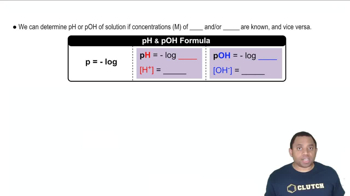Here are the essential concepts you must grasp in order to answer the question correctly.
Molarity (M)
Molarity is a measure of concentration defined as the number of moles of solute per liter of solution. It is expressed in moles per liter (mol/L). Understanding molarity is crucial for calculating how much solute is needed to achieve a desired concentration in a solution.
Recommended video:
pH and pOH
pH is a logarithmic scale used to specify the acidity or basicity of a solution, with lower values indicating higher acidity and higher values indicating higher basicity. The pH scale ranges from 0 to 14, where a pH of 7 is neutral. The relationship between pH and pOH is given by the equation pH + pOH = 14, which is essential for determining the concentration of hydroxide ions in basic solutions.
Recommended video:
Neutralization and Stoichiometry
Neutralization is a chemical reaction between an acid and a base that produces water and a salt. Stoichiometry involves using balanced chemical equations to calculate the amounts of reactants and products in a reaction. In this context, understanding the stoichiometric relationships helps determine how much KOH is needed to achieve the desired pH by calculating the corresponding hydroxide ion concentration.
Recommended video:

 Verified step by step guidance
Verified step by step guidance

